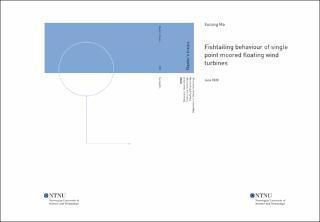| dc.description.abstract | The demand for clean energy is growing rapidly and the offshore wind industry is moving
from shallow water to an intermediate depth. When the water is deep enough, the floating
wind turbines are more feasible than the bottom-fixed wind turbines. However, the cost
of floating structures is still far beyond the price of bottom-fixed supporting structures.
Researchers proposed a single-point moored floating wind turbine concept aiming to reduce
the installation cost by using a simpler platform and reduce the number of mooring
lines. As the concept still has many challenges to solve, this thesis studied the fishtailing
behaviour of the single-point moored floating wind turbines.
In order to have a better understanding of the fishtailing behaviour of the single-point
moored turbine, literature research is conducted about wind turbine concepts and sideways
motions of single-point moored systems. Based on the existing barge-based floating
wind turbines, a 50m x 50m x 10m box-shaped barge model is built in GeniE and its
hydrodynamic results are gotten from HydroD. The barge model is then put into SIMA
and assembled with a DTU 10MW RWT. SIMA analysis can provide accurate results but
it is extremely time-consuming when the design needs to be frequently changed. Thus, a
quasi-static force linearised model is developed to provide a reasonable estimation of the
fishtailing behaviour with a reduced computation cost. The 6-DOF problem is simplified
to be a linear 3-DOF model with the surge, sway, and yaw motions considered. Static yaw
misalignment aerodynamic loads are obtained from SIMA on a fixed turbine and some of
the studies are compared with the OpenFAST result. These aerodynamic loads are taken
as position-dependent excitation force input in the simplified model.
The study of fishtailing behaviour is carried at a 30m/s high wind speed and at a 25m/s
cut-out wind speed. When a relatively long catenary mooring line is used, chaotic motion
shows up for the barge at high wind speed and a long-period fishtailing is observed when
the turbine is operating at cut-out. The initial studies are carried out on a turbine with a
75m tower-fairlead distance and a 125m long mooring line. The initial design fishtailing
behaviour is studied by using the linearised model and SIMA. The results show that the
linearised model can have a good estimation of the fishtailing period of a parked turbine
by using an estimated artificial stiffness. Meanwhile, it has reasonable prediction on the
stable position of an operating turbine. The linearised model is also used to find the stable
yaw misalignment and some of the simulations are repeated in SIMA for comparison. A
stable region is defined near cut-out wind speed to find out the bifurcation point of the
operating turbine fishtailing behaviour at cut-out wind speed.
Based on the simplified model and the SIMA results, a more optimal model is proposed to
reduce the fishtailing motion amplitude and to operate at a smaller yaw misalignment. The
tower-fairlead distance of the design is 100m and its mooring line length is 200m. The
dynamic motions and aerodynamic loads are compared with the initial design. Finally,
study findings are concluded and recommendations for future work are proposed. | |
